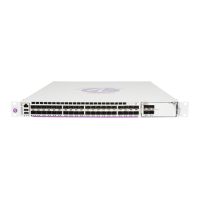Interfaces
Page 488 7750 SR Interface Configuration Guide
encap-type
Syntax encap-type {atm | bcp-null | bcp-dot1q | ipcp | ppp-auto | frame-relay | wan-mirror |cisco-
hdlc}
Context config>port>tdm>ds1>channel-group
config>port>tdm>ds3
config>port>tdm>e1>channel-group
config>port>tdm>e3
Context This command configures the encapsulation method used to on the specified port, path, or channel. This
parameter can be set on both access and network ports.
When the encap-type is set to ATM the CRC, timeslots, scrambling (if applicable), and idle-cycle-flags are
set to ATM defaults respectively. When the encap-type is changed from ATM, those parameters are set to
their non-ATM defaults.
When the encap-type is ATM, ATM sub-layer verification (GR-1248-CORE, Generic Requirements for
Operations of ATM Network Elements (NEs)) is automatically enabled. When ATM PLCP cell mapping is
used, the results of this verification include:
• PLCP Severely Errored Framing Seconds
• PLCP Alarm State
• PLCP Unavailable Seconds Counter
When ATM direct cell mapping is used, the result of the verification includes:
• Out of Cell Delineation (OCD) event count. The OCD event count is described in RFC 2515,
Definitions of Managed Objects for ATM Management. Note that multiple events occurring within
a second will be counted as 1 event for ASAP MDAs as a result of a hardware limit.
• Loss of Cell Delineation defect/alarm. The LCD defect/alarm is defined in RFC 2515, Definitions
of Managed Objects for ATM Management. When a path is in an LCD defect state, the path’s
operational status will be down. When a path exits the LCD state, the path’s operational status will
change to up (assuming nothing else causes the path to stay down). A trap is raised to indicate the
LCD status change. Also, a P-RDI is sent to indicate the defect to the remote end.
The no form of this command restores the default.
Default bcp-null
Parameters atm — Specifies the encapsulation on the port is ATM.
bcp-null — When selected, this keyword specifies that only a single service is configured on this channel
and IEEE 802.1Q tags are not used as a service delimiter. Any IEEE 802.1Q tags encountered are
regarded as part of the customer payload and transparently forwarded. When bcp-null encapsulation is
specified, the PPP Bridge Control Protocol (BCP) is activated and all packets on this access port will be
encapsulated in accordance with the BCP protocol.
bcp-dot1q — When selected, this keyword specifies that ingress frames carry IEEE 802.1Q tags and the
tags are used as service delimiter. Any untagged packets are silently discarded with exception of proto-
col specific packets. When bcp-dot1q encapsulation is specified, the PPP Bridge Control Protocol
(BCP) is activated and all packets on this access port will be encapsulated in accordance with the BCP
protocol.
